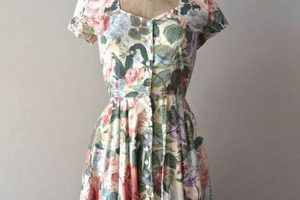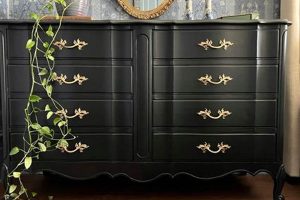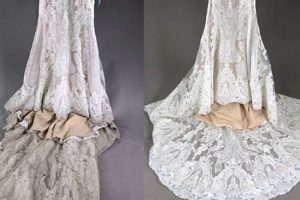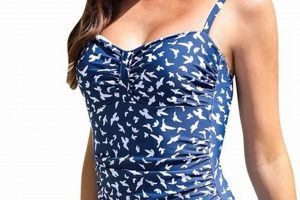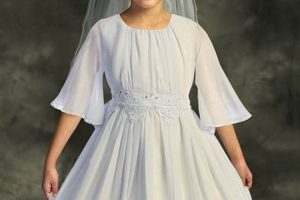A garment style originating from the era of Queen Victoria’s reign (1837-1901), characterized by features such as high necklines, fitted bodices, full skirts, and elaborate ornamentation. These pieces often incorporate fabrics like silk, velvet, and lace. An example would be a floor-length gown made of dark velvet with jet bead embellishments, circa 1880.
These articles of clothing represent a significant period in fashion history, embodying the social and aesthetic values of the time. Acquiring them allows access to the craftsmanship and design sensibilities of a bygone era, providing a tangible connection to historical trends. Their preservation is crucial for understanding the evolution of sartorial expression.
Subsequent sections will delve into specific aspects, encompassing construction techniques, popular materials, preservation strategies, and the continued influence of these historical garments on contemporary fashion designs.
The following guidelines offer insights into identifying, acquiring, and maintaining garments from the Victorian period. Adherence to these recommendations will enhance the longevity and value of such items.
Tip 1: Authenticate Construction Techniques: Examine seam finishes, closures, and internal structures. Original examples exhibit hand-sewn elements and specific construction methods characteristic of the era. Machine stitching, while present later in the period, should be evaluated for appropriateness.
Tip 2: Analyze Fabric Composition: Identify materials common during the Victorian era, such as silk, wool, cotton, and linen. Synthetic fibers indicate a later reproduction. Burn tests and microscopic fiber analysis may assist in authentication.
Tip 3: Assess Embellishment Integrity: Evaluate the condition of embellishments like beads, lace, and embroidery. Note any missing or damaged elements. Restoration, if necessary, should be undertaken by experienced textile conservators.
Tip 4: Consider Provenance and Documentation: Research the history of the item. Documentation, such as photographs or family histories, can significantly increase value and provide context.
Tip 5: Implement Proper Storage: Store garments in acid-free tissue paper within a climate-controlled environment. Avoid direct sunlight and fluctuations in temperature and humidity. Utilize padded hangers suitable for delicate fabrics.
Tip 6: Handle with Care: Avoid wearing fragile examples frequently. When handling, wear clean cotton gloves to prevent oil and dirt transfer.
Tip 7: Seek Professional Cleaning: Consult with a textile conservator for cleaning recommendations. Avoid harsh chemicals and washing machines. Spot cleaning should be performed by a trained professional.
Following these precepts ensures the longevity and preservation of these significant historical artifacts, allowing future generations to appreciate their craftsmanship and historical importance.
The subsequent section will explore the influence these designs had on modern fashion, as well as the continued relevance of vintage garments for fashion enthusiasts and collectors.
1. Silhouette
The silhouette serves as a defining characteristic of garments originating from the Victorian era. The shape these articles of clothing created was deliberately designed to convey specific social and aesthetic ideals. The structure and form of these dresses are instrumental in understanding their cultural significance.
- The Corset’s Influence
The corset played a pivotal role in achieving the hourglass figure synonymous with the period. This undergarment compressed the waist, creating a dramatic contrast with the full skirt. The silhouette dictated posture and movement, reflecting societal expectations of female deportment. For example, a tightly laced corset would emphasize the bust and hips, creating a distinct S-curve.
- The Bustle’s Impact
The bustle, a padded structure worn at the back of the skirt, altered the posterior silhouette, adding volume and shaping. This feature evolved throughout the Victorian period, ranging from subtle enhancements to exaggerated protrusions. This silhouette is notably visible in dresses from the 1870s and 1880s.
- Skirt Volume and Shape
The shape and volume of the skirt were crucial elements of the silhouette. Initially, skirts were supported by layers of petticoats, gradually evolving to the use of crinolines. This resulted in a bell-shaped skirt that emphasized the waist. Later styles incorporated more streamlined shapes, with fullness concentrated at the back. This design evolution affected freedom of movement.
- Sleeve Styles and Their Effects
Sleeve styles contributed to the overall silhouette. Sleeves varied from fitted to puffed, with embellishments like lace and ruffles adding further dimension. The size and shape of the sleeves influenced the perceived width of the shoulders and the balance of the silhouette. A large leg-of-mutton sleeve can drastically alter the look.
These interconnected elements worked in concert to produce silhouettes that reflected the values and aesthetics of the Victorian era. These silhouettes continue to captivate and inspire designers today, showcasing the enduring impact of these garments.
2. Fabrics
The selection and utilization of textiles constituted a defining element within garment construction during the Victorian era. The specific materials employed directly impacted the drape, texture, and overall aesthetic of garments, significantly influencing social perceptions and functionality. The availability and cost of these materials were also indicative of the wearer’s social standing. For example, silk, often imported, signaled wealth and status, while cotton, more readily accessible, was prevalent in garments for daily wear by the middle and lower classes.
Beyond mere aesthetics, fabric choices were inextricably linked to the practical needs and societal norms of the period. Heavy wools provided warmth and durability in outerwear, reflecting the era’s emphasis on practicality and modesty. Lightweight cottons and linens offered comfort in undergarments, demonstrating an awareness of hygiene and personal well-being, albeit within the constraints of the time. Furthermore, the development of synthetic dyes impacted fabric coloring, allowing for deeper and more vibrant hues. For example, the invention of mauveine in 1856 expanded the color palette available for garments, affecting design aesthetics.
A comprehensive understanding of fabric types is crucial for accurately identifying and preserving garments originating from the Victorian era. Analysis of fiber composition, weave structure, and dye characteristics offers valuable insights into the garment’s origins, intended purpose, and relative value. Consequently, recognizing these materials enables informed conservation efforts, ensuring the longevity and continued appreciation of these historical textiles. Failure to properly identify and address the specific needs of a particular fabric can lead to irreversible damage and loss of valuable historical information. This emphasis on proper care ensures the survival of these garments for future study and enjoyment.
3. Embellishments
Ornate embellishments constitute an integral characteristic of garments originating from the Victorian era. These decorative elements, ranging from delicate lace to elaborate beadwork, served not merely as adornment but as indicators of social status, personal taste, and the occasion for which the garment was intended. The application of these features directly influenced the perceived value and aesthetic appeal. For instance, a gown embellished with hand-embroidered silk threads and genuine gemstones signaled affluence and discerning taste, whereas a dress adorned with simpler, machine-made lace indicated a more modest social standing. The types and extent of embellishments directly impacted the overall presentation of the garment.
The prevalence of specific types of embellishments often correlated with prevailing fashion trends and technological advancements of the time. The invention of automated lace-making machines allowed for wider accessibility to lace, leading to its increased use in garments across various social strata. Similarly, the introduction of new dyeing techniques enabled the creation of vibrant colors in beads and embroidery threads, further expanding the possibilities for decorative designs. These technological developments consequently shaped the visual landscape of Victorian fashion. The condition of these embellishments is now a critical factor in determining the authenticity and value of existing historical examples.
Understanding the significance of embellishments allows for more informed analysis and preservation of these historical artifacts. Examination of the materials, techniques, and motifs employed in ornamentation provides insights into the social, economic, and cultural context of the time. However, challenges remain in properly conserving these delicate elements, as they are often susceptible to damage from environmental factors and improper handling. The preservation of these decorative details ensures the continued appreciation and study of these remarkable garments and their historical relevance.
4. Construction
The construction methods employed in creating garments from the Victorian era are critical in understanding their design, durability, and overall historical significance. These techniques reflect the prevailing technologies, social structures, and aesthetic ideals of the period, providing essential insights into the lives of those who wore them and the artisans who crafted them.
- Hand-Sewing Techniques
Prior to the widespread adoption of sewing machines, hand-sewing was the primary method of garment construction. Skilled seamstresses employed various stitches, including backstitch, running stitch, and whipstitch, to assemble garments. The precision and durability of these hand-sewn seams are testaments to the craftsmanship of the era. Examples include intricate bodice seams and meticulously finished hemlines often found in extant garments. The presence of extensive hand-sewing is a key indicator of authenticity and age.
- Use of Corsetry and Understructures
Victorian garments relied heavily on understructures to achieve their characteristic silhouettes. Corsets, bustles, and crinolines shaped the body and supported the weight of voluminous skirts. The construction of these underpinnings involved specialized techniques, such as boning, padding, and layering of fabrics. The precise fit and construction of corsets were essential for achieving the desired shape and providing support. Examples include whalebone corsets with intricate lacings and layered crinolines made from horsehair or steel. The presence and condition of these understructures are essential for understanding the intended form of the outer garment.
- Seam Finishes and Fabric Manipulation
Victorian garment construction emphasized clean and durable seam finishes. Techniques such as French seams, felled seams, and bias binding were used to prevent fraying and enhance the longevity of garments. Fabric manipulation techniques, such as pleating, gathering, and tucking, added dimension and texture to garments. Examples include neatly finished seams on silk bodices and expertly pleated skirts on woolen dresses. These details demonstrate the attention to detail and skill of Victorian seamstresses.
- Fastening Mechanisms
The fastening mechanisms used in garments reflect the available technology and the prevailing fashion trends. Hooks and eyes, buttons, and lacings were commonly used to secure garments. The materials and construction of these fastenings varied depending on the garment’s purpose and the wearer’s social status. Examples include hand-covered buttons on velvet jackets and intricate hook-and-eye closures on silk gowns. The type and condition of fastening mechanisms provide clues to the garment’s age and authenticity.
In essence, the construction of garments from the Victorian era is a reflection of the period’s technological capabilities, social customs, and aesthetic preferences. Analyzing the construction techniques provides valuable insights into the lives of those who created and wore these garments, contributing to a more comprehensive understanding of the historical context. The preservation of these construction details is therefore crucial for maintaining the integrity and historical value of extant examples.
5. Etiquette
During the Victorian era, social etiquette profoundly influenced all aspects of life, and clothing, particularly women’s attire, served as a visual indicator of adherence to these stringent codes of conduct. The garments, therefore, were not merely articles of clothing but rather meticulously constructed expressions of social standing and adherence to prescribed norms. Understanding the connection between attire and etiquette is crucial for fully appreciating the significance and function of a “vintage victorian dress”.
- Appropriateness of Attire for Occasions
Victorian society dictated precise dress codes for different events, ranging from morning visits to evening balls. Wearing a “vintage victorian dress” that was unsuitable for a particular occasion would be a grave breach of etiquette. For instance, a heavily ornamented gown appropriate for an evening gala would be entirely inappropriate for a daytime garden party. The selection of fabric, color, and embellishments needed to adhere to strict guidelines to reflect the wearer’s understanding and respect for social norms.
- The Significance of Mourning Dress
Mourning rituals were elaborate and strictly regulated in Victorian society, and mourning dress played a central role. The color, fabric, and style of the dress indicated the wearer’s relationship to the deceased and the length of the mourning period. A “vintage victorian dress” in somber black crepe, devoid of ornamentation, would signify a widow’s profound grief, while lighter shades of grey or lavender would be worn as the mourning period progressed. Deviations from these prescribed codes were viewed as disrespectful and socially unacceptable. Queen Victoria’s prolonged mourning period after Prince Albert’s death served as an exemplar of this custom.
- The Language of Flowers and Colors
Victorian etiquette extended to the symbolic use of flowers and colors in clothing. The color of a dress or the flowers adorning it could convey specific messages or sentiments. A “vintage victorian dress” featuring certain floral patterns or hues could express love, friendship, or even mourning. Understanding this symbolic language is important in interpreting the intended meaning of the garment. For example, wearing a dress with red roses might signify romantic affection, while wearing violets could symbolize mourning or remembrance.
- The Role of Accessories
Accessories, such as gloves, hats, and parasols, were integral components of Victorian attire and subject to strict etiquette. The correct wearing of these items was essential for maintaining a respectable appearance. The choice of glove length, hat style, and parasol design depended on the time of day, the occasion, and the wearer’s social status. Wearing inappropriate accessories with a “vintage victorian dress” would be considered a faux pas. For example, wearing short gloves to a formal evening event or carrying a brightly colored parasol during a period of mourning would be seen as a significant breach of social protocol.
These interconnected aspects of etiquette and attire highlight the complex and nuanced relationship between clothing and social behavior in the Victorian era. A “vintage victorian dress” therefore provides a tangible window into the values, beliefs, and expectations of this fascinating period in history. Examining these garments through the lens of etiquette offers a deeper understanding of their significance beyond mere aesthetics.
6. Preservation
The preservation of a “vintage victorian dress” is a critical undertaking due to the inherent fragility of the materials and construction techniques employed during the era. These garments, often crafted from delicate silks, wools, and laces, are susceptible to damage from environmental factors such as light, humidity, and pests. Improper storage and handling can lead to irreversible deterioration, diminishing the garment’s historical value and aesthetic appeal. The preservation process, therefore, is not merely about maintaining the garment’s current state but about actively preventing future degradation. For example, exposure to ultraviolet light can fade dyes and weaken fibers, while fluctuations in humidity can cause fabrics to expand and contract, leading to stress and eventual damage.
Effective preservation strategies involve a multi-faceted approach, encompassing appropriate storage, handling, and cleaning protocols. Storage solutions include using acid-free tissue paper to cushion the garment, storing it in a climate-controlled environment with stable temperature and humidity levels, and utilizing padded hangers to prevent distortion. Handling necessitates the use of clean cotton gloves to avoid transferring oils and dirt to the fabric. Cleaning, when necessary, should be performed by trained textile conservators who understand the unique challenges posed by these delicate materials. For example, a dress from the 1880s made of silk velvet might require specialized solvent cleaning techniques to remove soiling without damaging the nap of the fabric. The practical significance of these preservation methods lies in ensuring that future generations can study and appreciate these artifacts.
In conclusion, the preservation of a “vintage victorian dress” is an essential endeavor for safeguarding cultural heritage. The challenges associated with preserving these delicate garments necessitate a proactive and informed approach, involving proper environmental control, careful handling, and specialized cleaning techniques. The long-term benefits of these efforts are immeasurable, as they allow for the continued study and appreciation of the artistry and history embodied in these remarkable articles of clothing.
Frequently Asked Questions
The following addresses prevalent queries pertaining to identifying, acquiring, preserving, and appreciating garments from the Victorian era.
Question 1: What are the defining characteristics that distinguish a genuine article from a reproduction?
Authentic examples typically exhibit hand-sewn construction, period-appropriate fabrics (e.g., silk, wool, fine cotton), and fasteners (e.g., hooks and eyes, hand-set buttons). Reproductions often utilize synthetic fabrics, machine stitching, and modern closures. Examination of construction details and fiber analysis can assist in determining authenticity.
Question 2: How should pieces be stored to prevent damage and deterioration?
Optimal storage involves using acid-free tissue paper for padding and support, storing the garment in a climate-controlled environment with stable temperature and humidity (ideally 65-70F and 45-55% relative humidity), and utilizing padded hangers suitable for delicate fabrics. Direct sunlight and extreme temperature fluctuations should be avoided.
Question 3: What are the ethical considerations when acquiring vintage garments, particularly those with historical significance?
Acquisition should prioritize responsible sourcing, avoiding items that may have been obtained through unethical means (e.g., looting, theft). Respect for cultural heritage and provenance research are crucial. Supporting reputable dealers and auction houses that adhere to ethical guidelines ensures responsible collecting practices.
Question 4: Can cleaning these garments at home be undertaken?
In general, home cleaning is discouraged due to the fragility of the materials and construction. Professional cleaning by a qualified textile conservator is recommended. If home cleaning is unavoidable, proceed with extreme caution, using gentle, pH-neutral detergents and avoiding harsh chemicals or agitation.
Question 5: What are the common types of damage affecting garments from the Victorian era, and how can these be mitigated?
Common damage includes light-induced fading, fiber degradation due to acid hydrolysis, pest infestations (e.g., moths, silverfish), and mechanical damage from improper handling. Mitigation strategies involve controlled storage environments, regular inspections for pests, and careful handling techniques.
Question 6: How does contemporary fashion draw inspiration from pieces of the Victorian era?
Modern designers often reinterpret elements, such as high necklines, lace detailing, and fitted bodices, into contemporary silhouettes. The influence can be seen in bridal wear, evening gowns, and even everyday apparel. Understanding the historical context enriches appreciation of these contemporary interpretations.
Careful consideration of these factors is crucial for responsible stewardship and appreciation of garments from the Victorian era.
Subsequent sections will delve into the enduring legacy and continuing relevance of these historical garments.
Conclusion
This exploration has illuminated the multifaceted nature of vintage victorian dress, encompassing its construction, materials, etiquette, and preservation. These garments serve as tangible artifacts, reflecting the social, economic, and aesthetic values of a transformative era. Recognizing the nuances of their creation and the challenges of their conservation is paramount to understanding their historical importance.
The ongoing study and careful preservation of these garments are essential to ensuring that future generations can appreciate their artistry and gain insights into the Victorian period. Continued scholarly inquiry and responsible stewardship are crucial for maintaining the integrity of these valuable cultural assets, fostering a deeper appreciation for the past.



